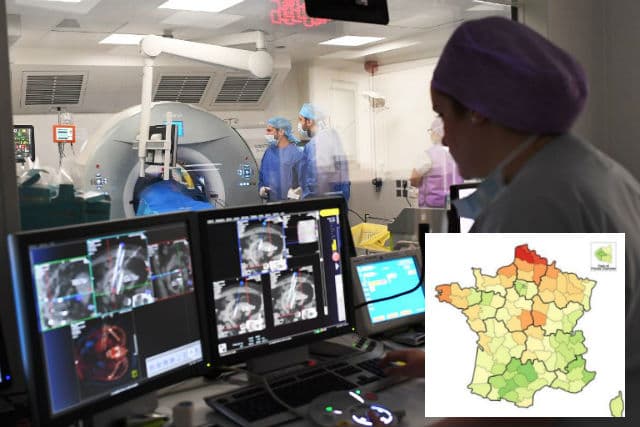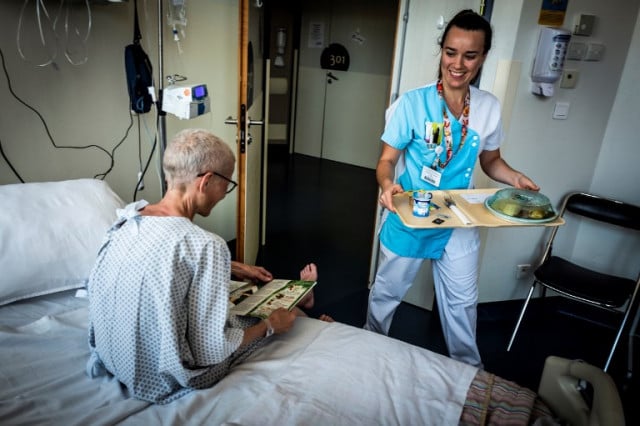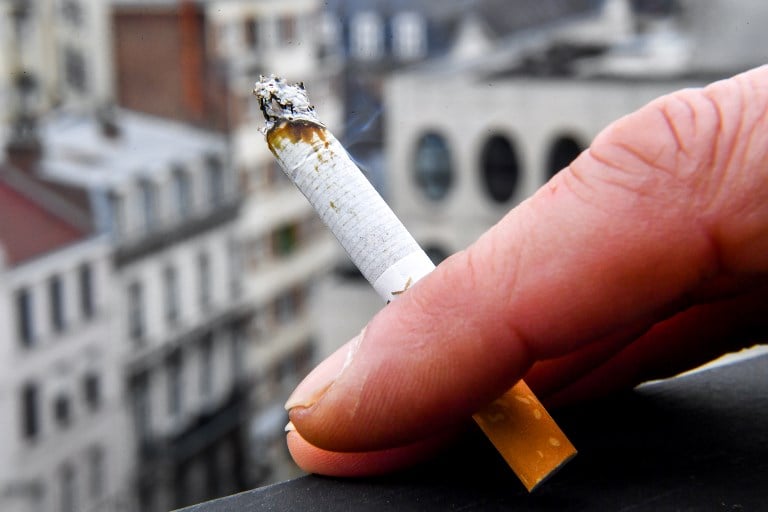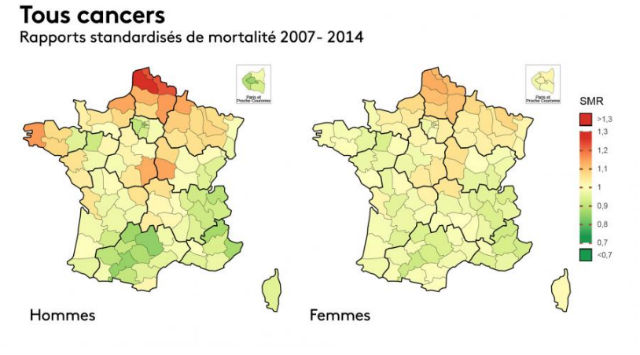How cancer rates compare in each region of France

A new health study reveals which kinds of cancers are more prevalent in each French region and the mortality rates associated with them. And there are some worrying results for those in Brittany and the north.
The report by France's national health body Sante France Publique, published this week, looks at all the cases of cancer in France and mortality rates, region by region between 2007 and 2016.
The study reveals that different types of cancer tend to be more prevalent in certain regions.
And somewhat worryingly for the north western region of Brittany and Hauts-de-France in the north, there are several types of cancer people in these regions have a higher chance of developing.
For example more people suffer from cancer of the lip, mouth or pharynx in both of these regions compared to elsewhere in France.
READ ALSO:
 A member of staff carries a trail with a meal for a patient of the Cancer center at the hospital Leon Berard, in Lyon. Photo: AFP
These two regions also have the highest number of cases of oesophagus, liver and testicular cancer.
Meanwhile in Brittany more people develop stomach and skin cancer while in the Hauts-de-France cancers of the colon and rectum, larynx, lung, breast and bladder are overrepresented.
So, why are these two regions hit hardest by a variety of different kinds of cancer?
It seems like the answer could be linked to lifestyle choices, according to doctors.
"What we know about these cancers, for example cancer of the mouth, pharynx, oesophagus, stomach and lungs, is that they are encouraged by tobacco and alcohol consumption.
"It is assumed that this overlaps, but it is very difficult to give a more advanced explanation than this one," said Édouard Chatignoux, from Sante France Publique.
A member of staff carries a trail with a meal for a patient of the Cancer center at the hospital Leon Berard, in Lyon. Photo: AFP
These two regions also have the highest number of cases of oesophagus, liver and testicular cancer.
Meanwhile in Brittany more people develop stomach and skin cancer while in the Hauts-de-France cancers of the colon and rectum, larynx, lung, breast and bladder are overrepresented.
So, why are these two regions hit hardest by a variety of different kinds of cancer?
It seems like the answer could be linked to lifestyle choices, according to doctors.
"What we know about these cancers, for example cancer of the mouth, pharynx, oesophagus, stomach and lungs, is that they are encouraged by tobacco and alcohol consumption.
"It is assumed that this overlaps, but it is very difficult to give a more advanced explanation than this one," said Édouard Chatignoux, from Sante France Publique.
 Photo: AFP
But it wasn't only Brittany and the Hauts-de-France that had high levels of certain cancers.
The regions of Nouvelle-Aquitaine in the south west, Provence-Alpes-Côte d'Azur in the south east and Auvergne-Rhône-Alpes had higher levels of thyroid cancer than elsewhere in the country.
Meanwhile the Grand Est had highers levels of cancer of the uterus, in Corsica lung cancer was more prevalent than in other regions and in central French regions death from prostate cancer was higher than elsewhere.
Interestingly, for almost all types of cancer, the greater Paris region of Île-de-France and Occitanie in the south west appeared to be the least affected.
In France, between 2007 and 2016, the number of new cases of cancer was estimated at 356,109 per year (55.3 percent of which affected men).
Between 2007 and 2014 the average number of deaths in France from cancer was 152,556 per year (89,140 for men and 63,416 women).
The maps below uses a colour chart to indicate how many cancer-related deaths hit different areas of the country.
The intensity of the color varies between a darker shade of green for an unusually low number of cancer-related deaths to dark red, with yellow representing places where the death rate is around the national averag
In the map on the left, which shows the cancer-related death rate for men, the far north of France is coloured dark red, which represents an unusually high death rate, according to the national average.
Photo: AFP
But it wasn't only Brittany and the Hauts-de-France that had high levels of certain cancers.
The regions of Nouvelle-Aquitaine in the south west, Provence-Alpes-Côte d'Azur in the south east and Auvergne-Rhône-Alpes had higher levels of thyroid cancer than elsewhere in the country.
Meanwhile the Grand Est had highers levels of cancer of the uterus, in Corsica lung cancer was more prevalent than in other regions and in central French regions death from prostate cancer was higher than elsewhere.
Interestingly, for almost all types of cancer, the greater Paris region of Île-de-France and Occitanie in the south west appeared to be the least affected.
In France, between 2007 and 2016, the number of new cases of cancer was estimated at 356,109 per year (55.3 percent of which affected men).
Between 2007 and 2014 the average number of deaths in France from cancer was 152,556 per year (89,140 for men and 63,416 women).
The maps below uses a colour chart to indicate how many cancer-related deaths hit different areas of the country.
The intensity of the color varies between a darker shade of green for an unusually low number of cancer-related deaths to dark red, with yellow representing places where the death rate is around the national averag
In the map on the left, which shows the cancer-related death rate for men, the far north of France is coloured dark red, which represents an unusually high death rate, according to the national average.
 In June 2018 another study by Sante France Publique revealed that the French needlessly put themselves at risk of developing cancer by smoking, drinking and eating unhealthily.
The study by French health authority Santé publique France said that four out of ten cancer cases could be avoided by a change in behaviour.
In June 2018 another study by Sante France Publique revealed that the French needlessly put themselves at risk of developing cancer by smoking, drinking and eating unhealthily.
The study by French health authority Santé publique France said that four out of ten cancer cases could be avoided by a change in behaviour.
Comments
See Also
The report by France's national health body Sante France Publique, published this week, looks at all the cases of cancer in France and mortality rates, region by region between 2007 and 2016.
The study reveals that different types of cancer tend to be more prevalent in certain regions.
And somewhat worryingly for the north western region of Brittany and Hauts-de-France in the north, there are several types of cancer people in these regions have a higher chance of developing.
For example more people suffer from cancer of the lip, mouth or pharynx in both of these regions compared to elsewhere in France.
READ ALSO:

A member of staff carries a trail with a meal for a patient of the Cancer center at the hospital Leon Berard, in Lyon. Photo: AFP
These two regions also have the highest number of cases of oesophagus, liver and testicular cancer.
Meanwhile in Brittany more people develop stomach and skin cancer while in the Hauts-de-France cancers of the colon and rectum, larynx, lung, breast and bladder are overrepresented.
So, why are these two regions hit hardest by a variety of different kinds of cancer?
It seems like the answer could be linked to lifestyle choices, according to doctors.
"What we know about these cancers, for example cancer of the mouth, pharynx, oesophagus, stomach and lungs, is that they are encouraged by tobacco and alcohol consumption.
"It is assumed that this overlaps, but it is very difficult to give a more advanced explanation than this one," said Édouard Chatignoux, from Sante France Publique.

Photo: AFP
But it wasn't only Brittany and the Hauts-de-France that had high levels of certain cancers.
The regions of Nouvelle-Aquitaine in the south west, Provence-Alpes-Côte d'Azur in the south east and Auvergne-Rhône-Alpes had higher levels of thyroid cancer than elsewhere in the country.
Meanwhile the Grand Est had highers levels of cancer of the uterus, in Corsica lung cancer was more prevalent than in other regions and in central French regions death from prostate cancer was higher than elsewhere.
Interestingly, for almost all types of cancer, the greater Paris region of Île-de-France and Occitanie in the south west appeared to be the least affected.
In France, between 2007 and 2016, the number of new cases of cancer was estimated at 356,109 per year (55.3 percent of which affected men).
Between 2007 and 2014 the average number of deaths in France from cancer was 152,556 per year (89,140 for men and 63,416 women).
The maps below uses a colour chart to indicate how many cancer-related deaths hit different areas of the country.
The intensity of the color varies between a darker shade of green for an unusually low number of cancer-related deaths to dark red, with yellow representing places where the death rate is around the national averag
In the map on the left, which shows the cancer-related death rate for men, the far north of France is coloured dark red, which represents an unusually high death rate, according to the national average.

In June 2018 another study by Sante France Publique revealed that the French needlessly put themselves at risk of developing cancer by smoking, drinking and eating unhealthily.
The study by French health authority Santé publique France said that four out of ten cancer cases could be avoided by a change in behaviour.
Join the conversation in our comments section below. Share your own views and experience and if you have a question or suggestion for our journalists then email us at [email protected].
Please keep comments civil, constructive and on topic – and make sure to read our terms of use before getting involved.
Please log in here to leave a comment.